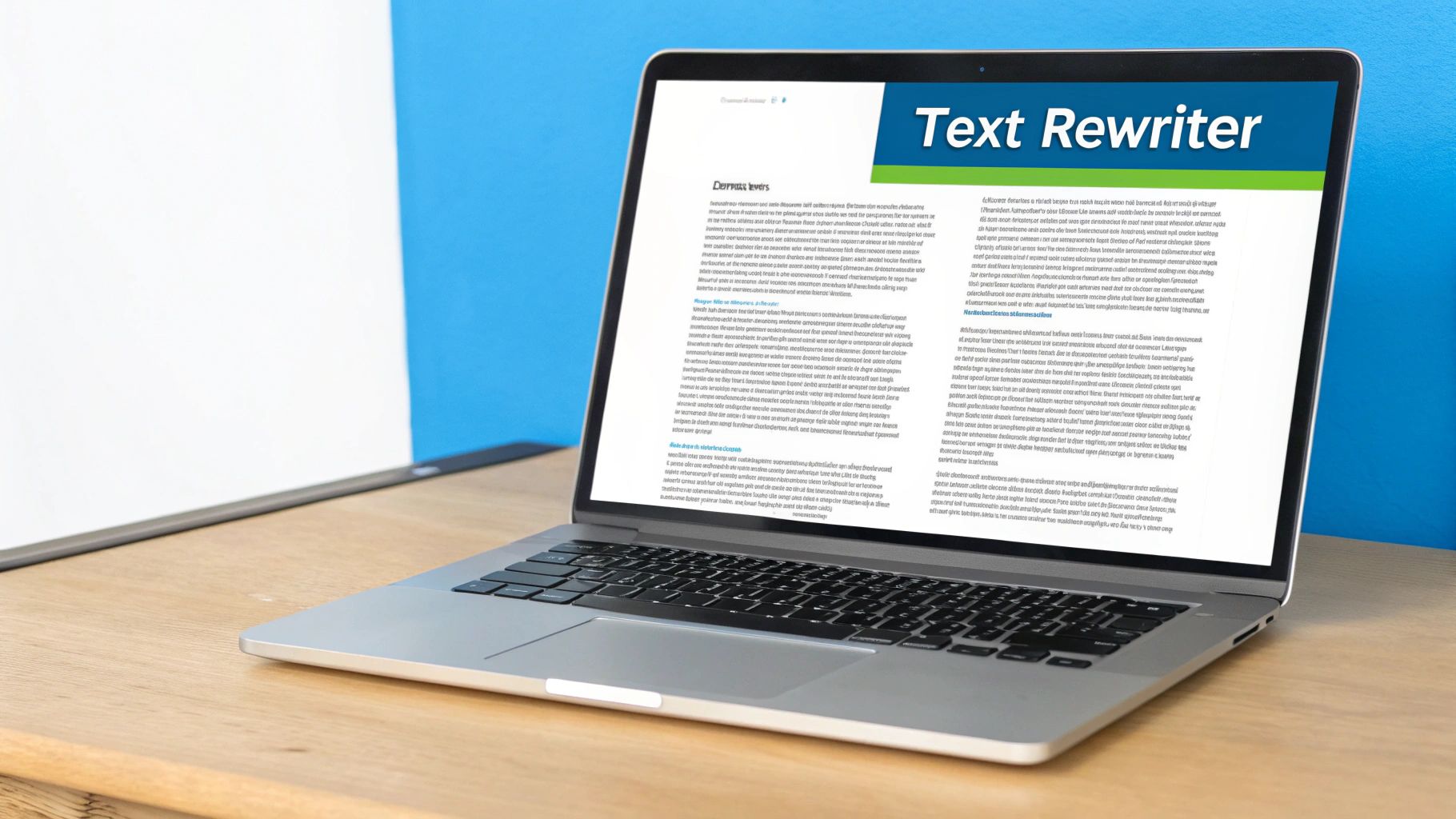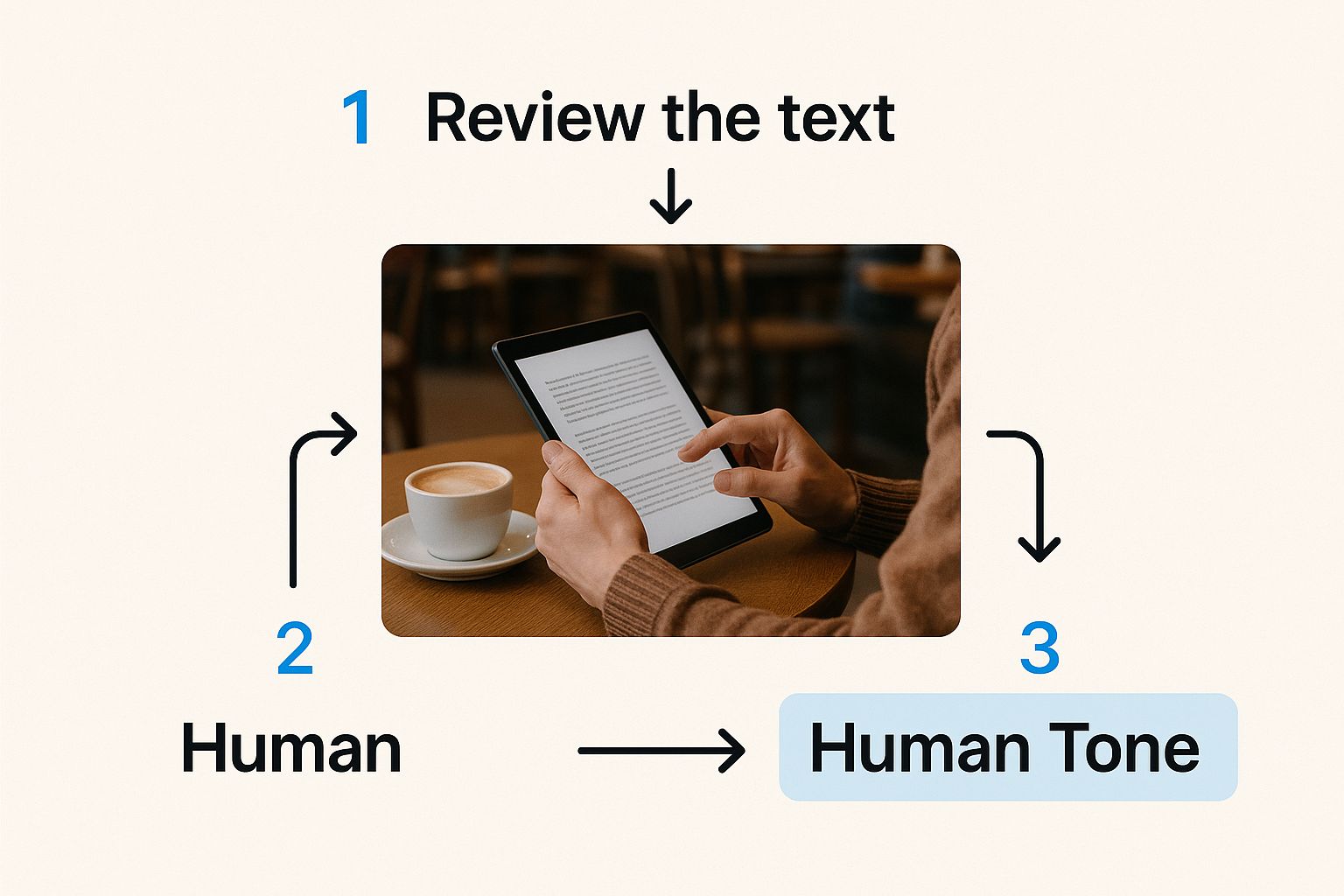Your Guide to Making ChatGPT Sound Human

A ChatGPT rewriter can be a big help for smoothing out AI-generated text, making its structure, tone, and words sound more natural. The best tools don't just swap out a few words; they change the content to give it a more interesting, human rhythm.
Why AI Writing Still Needs a Human Touch
Let’s be honest—you can usually spot AI writing from a mile away. It’s great for brainstorming and getting a first draft down, but the final piece often feels stiff, overly formal, and just… off. That mechanical feel is a major problem if you're trying to really connect with an audience.
The content might be grammatically perfect, but it almost always lacks the personality and small details that build trust with a reader. This is a key point we get into in our guide on why humanizing AI content is essential for engagement. When your audience notices that robotic tone, they're far more likely to tune out.
The Telltale Signs of a Machine
AI-made content has a few dead giveaways. Studies have shown that machine writing often falls back on predictable sentence patterns, like using "not just… but also" over and over. It also tends to have a relentlessly positive, almost sterile, tone that just doesn't feel real compared to how people actually express themselves.
Other common red flags include:
- Repetitive Sentence Starters: You'll often see paragraphs starting with the same few phrases, which makes for a dull, boring read.
- Lack of Personal Voice: The text feels general, with no opinions, stories, or a clear point of view showing through.
- Overly Explanatory Tone: AI has a habit of explaining simple things in great detail, which can come across as talking down to the reader.
The core issue isn't about grammar or spelling; it's about being genuine. Human writing is imperfect, varied, and full of small signs that a machine struggles to copy.
Understanding these differences is the first step. To help you spot them more easily, here’s a quick breakdown of what sets AI and human writing apart.
AI Writing vs. Human Writing: Key Differences
This table points out the usual traits of AI-generated text compared to content written by a person, helping you quickly spot the differences.
| Characteristic | Typical AI-Generated Text | Typical Human-Written Text |
|---|---|---|
| Tone & Voice | Often formal, neutral, or always positive. Lacks a distinct personality. | Varies naturally. Can be conversational, funny, or serious. Full of personality. |
| Sentence Structure | Tends to be repetitive and predictable. Uses complex sentences often. | Mixes short, punchy sentences with longer, more descriptive ones for better rhythm. |
| Word Choice | Relies on a safe, common vocabulary. Can sound generic or too academic. | Uses a wider, more specific vocabulary, including idioms, slang, and personal phrasing. |
| Flow & Transitions | Can feel choppy or formulaic, with robotic transitions like "Furthermore…" | Moves smoothly between ideas with natural, conversational transitions. |
| Emotion & Anecdotes | Lacks personal stories, opinions, and emotional depth. | Often includes anecdotes, personal thoughts, and emotional context to connect with readers. |
| Imperfections | Grammatically perfect, but can feel sterile and flawless to a fault. | Contains natural imperfections, quirks, and a style that feels authentic. |
Knowing these distinctions makes it much easier to guide a rewriter tool or your own editing process to add that much-needed human touch.
Even in highly structured fields, that human oversight is irreplaceable. For instance, the best practices for technical writing stress clarity and context—two areas where a human editor’s judgment is invaluable. The goal of a chatgpt rewriter human process isn’t to erase the AI’s work, but to layer it with a genuine, relatable feel that actually connects.
Choosing the Right Tool to Humanize Your Content
Let's be real: not every rewriting tool actually gets what human language is all about. Many of the basic spinners out there just swap out words, which is a fast track to awkward phrasing and content that still screams "robot."
To really make AI content sound human, you need a tool that acts more like a writing partner than a simple thesaurus.
The goal is to find a chatgpt rewriter human solution that goes much deeper than surface-level edits. It needs to vary sentence structures, create a natural rhythm, and hold onto your original meaning without muddying the waters. That's the real difference between a cheap fix and a quality rewrite.
What to Look For in a Rewriter
When you're shopping around, focus on tools that can deliver a genuinely natural output. The best ones are built to understand context and intent, not just individual words.
Here are a few must-haves to look for:
- Structural Variety: Does it mix up sentence lengths and patterns on its own? A good tool will break up those monotonous AI structures without you having to do it by hand.
- Tone Adjustment: Can you tell it to be more conversational, witty, or professional? This is vital for matching the content to your brand’s voice.
- Meaning Preservation: The rewrite has to stay true to the original message. It can’t start changing facts or twisting the main argument you’re trying to make.
The true test of a great rewriter is its ability to give you content that doesn't need a ton of heavy editing. It should handle the heavy lifting, leaving you to just add your final personal touches.
A top-tier tool like Word Spinner is made for this exact challenge, offering advanced rewriting that makes text sound natural. It helps get past AI detection and provides completely original, plagiarism-free content.
For a deeper look, check out our guide on finding the best AI humanizer to fit your specific needs.
A Practical Method for Rewriting AI Content
Turning a raw AI draft into something genuinely compelling isn't about replacing the AI; it's about partnering with it. I've found the best method involves letting a chatgpt rewriter human process do the heavy lifting—restructuring and rephrasing—while I come in at the end to add the final layer of personality.
Think of it as a three-part dance. You prep the text, guide the tool, and then step in for the final hands-on polish.
First, you need a clean starting point. Give the initial ChatGPT output a quick once-over for any glaring factual errors or sentences that just don't make sense. Don't get stuck on wording yet, just make sure the core information is solid. From there, you'll feed it to your rewriting tool with some clear instructions before letting it work its magic.
The infographic below really shows how a thoughtful review process can change the tone of AI text, making it far more relatable.
This just goes to show how vital human oversight is for hitting that authentic voice that actually connects with an audience.
Applying the Final Human Polish
Once the tool has done its thing, it’s your turn to add the irreplaceable human element. This final hands-on review is where you inject your unique voice and point of view.
This is your chance to weave in personal stories, share specific examples from your own experience, and add those little quirks that make your writing sound like you. For a deeper look into this stage, check out our guide on how to humanize ChatGPT text manually.
This final step is more important than ever. Since its launch, ChatGPT has grown to hold a 60.6% market share in the AI industry. Yet, 63.5% of users admit they can’t reliably tell the difference between human writing and text from newer models, which really blurs the lines of authenticity.
Before and After: A Rewriting Example
To see this method in action, let's look at a typical, sterile AI-generated paragraph and see how we can breathe some life into it.
Before (Original AI Text):
"The implementation of a new software system is a multifaceted undertaking that necessitates careful planning. It is imperative for stakeholders to communicate effectively to ensure alignment on project goals. The successful deployment of the software will result in increased operational efficiency across various departments within the organization."
Technically correct? Yes. Interesting? Not in the slightest. It’s robotic, stuffed with jargon, and completely lacks any personality.
After (Rewritten and Humanized):
"Rolling out new software is always a bigger job than it seems, right? It takes serious planning to get it right. If the people involved aren't talking to each other and on the same page, things can go sideways fast. But when everyone works together, the new system can make everyone's jobs a whole lot easier."
See the difference? The "after" version is conversational, relatable, and clear. It ditches the corporate-speak for simple language and adopts a more personal tone, making the same point in a much more engaging way. That’s the goal of any effective rewriting process.
Advanced Tips for a Truly Human Voice
Basic rewriting is a good start, but if you want your content to really connect, you have to master the finer points of the human voice. A solid chatgpt rewriter human method isn't just about sounding correct—it's about sounding real.
This means stepping beyond perfect grammar and embracing the beautiful messiness of how people actually talk and write.
One of the quickest ways to do this is by weaving in idioms and everyday sayings. Instead of a stiff phrase like, "It is a difficult situation," you could try, "It's a tough pill to swallow." That simple swap adds a layer of personality that AI just can't nail on its own, creating a more conversational vibe with your reader.
Bending the Rules for Impact
Let's be honest—sometimes the most human-sounding writing isn't perfectly grammatical. Don't be afraid to bend the rules a little for the sake of rhythm and impact.
- Use sentence fragments. For emphasis. See how that works?
- Start sentences with conjunctions. And it feels natural because it’s how we speak.
- Mix up your paragraph lengths. A mix of longer, detailed explanations and short, punchy single-sentence paragraphs creates a lively flow that keeps readers hooked.
This kind of intentional imperfection shatters the monotonous, robotic rhythm that plagues so much AI text. It feels less like a report and more like a real conversation. For more on this, check out our guide on how to make ChatGPT answer like a human.
Finding Your Brand's Unique Tone
Beyond the nuts and bolts of phrasing, the real magic happens when you line up the tone with your brand. The default AI voice is helpful but general. Is your brand witty? Authoritative? Empathetic? As you review your rewritten drafts, always ask if the voice truly reflects your identity.
For example, a tech startup might go for an energetic, bold tone. A financial advisor, on the other hand, would want something more measured and trustworthy. Nailing that final tonal match is a distinctly human touch.
Applying these fine points consistently takes time and a sharp eye. For writers who need great results without the extra hours, a tool like Word Spinner is a huge help. It helps you make these subtle changes more quickly, creating content that feels completely authentic and true to your brand. Your message won't just be heard; it will connect.
Common Traps to Avoid When Humanizing AI Text
It’s surprisingly easy to go too far when trying to humanize AI content. You start with the best intentions, but a few common missteps can actually make your text weaker, not stronger. The whole point of using a chatgpt rewriter human approach is to improve the content, not accidentally gut it.
Don't Edit the Soul Out of It
One of the biggest mistakes I see is over-editing. You can polish and tweak a paragraph so much that you scrub away the original meaning. It’s a delicate balance—you want to inject your unique voice and personality without losing the core message or the useful details your AI draft gave you in the first place.
Another classic error is accidentally introducing wrong information. While you're busy making sentences flow better, it's easy to unintentionally change a key fact or number. This is especially dangerous with technical or data-heavy topics where precision is everything.
Getting the Tone All Wrong
Mismatched tone is another common pitfall. Making a serious subject sound overly casual or "salesy" will alienate your audience in a heartbeat. On the flip side, using stiff, academic language for a fun, lighthearted blog post feels just as jarring and out of place. Always step back and ask: does this voice actually fit the message?
This is where you really see the limitations of today's AI. For example, a year-long study that tested ChatGPT's ability to produce credible science journalism gave it a pretty dismal score of just 2.26 out of 5. It’s a stark reminder of how badly complex topics can be mangled without a knowledgeable human steering the ship. You can dig into the specifics of AI's performance in specialized writing if you're curious.
Know Your Tool's Limits
Finally, you have to be realistic about what these rewriters can actually do. For highly technical, scientific, or medical content, think of them as a helpful assistant, not the expert in the room.
A rewriter is fantastic for improving structure and smoothing out awkward phrasing, but it can't replace the deep knowledge of a subject matter expert. When accuracy is non-negotiable, you absolutely need a final review from a professional in that field.
Your Top Questions About Humanizing AI, Answered
You've got questions about using a rewriter to make AI text sound human, and that's smart. Let's get straight to the answers you're looking for, based on what we see every day.
Will AI Detectors Still Flag My Content After Rewriting It?
Honestly, it depends on the rewriter you use. A lot of basic tools just perform simple word swaps, and yeah, that kind of stuff can still get flagged pretty easily.
A high-quality rewriter does much more. It overhauls sentence structures, adjusts the tone, and even changes the rhythm of the text to mimic a real person's writing. The final, crucial step is your own manual edit. That's where you add your unique voice and those little unpredictable touches that AI detectors just aren't built to understand.
How Much Editing Is Really Needed After Using a Rewriter?
Think of the rewriter as a very talented assistant, not a magic button. The amount of editing really comes down to what you're creating.
If it's just a quick internal draft, a simple once-over for clarity might be all you need. But for important stuff like a new blog post or your website's main copy? You absolutely need to roll up your sleeves and do a proper final review. Your job is to inject personal stories, brand-specific examples, and make sure your company's voice shines through. The tool lays the foundation; you build the house.
Is It Actually Ethical to Use a Rewriter on AI Content?
Using tools to write better and faster is nothing new—it's just part of how content gets made these days. The real question is about the quality and honesty of the final piece.
As long as the information you're providing is accurate and the content genuinely serves your reader, using a chatgpt rewriter human process is just an efficient, ethical way to improve your work. It's about refining the language, not misrepresenting the facts.
Ready to turn those robotic AI drafts into content that truly connects? Give Word Spinner a try today and feel the difference it makes.


